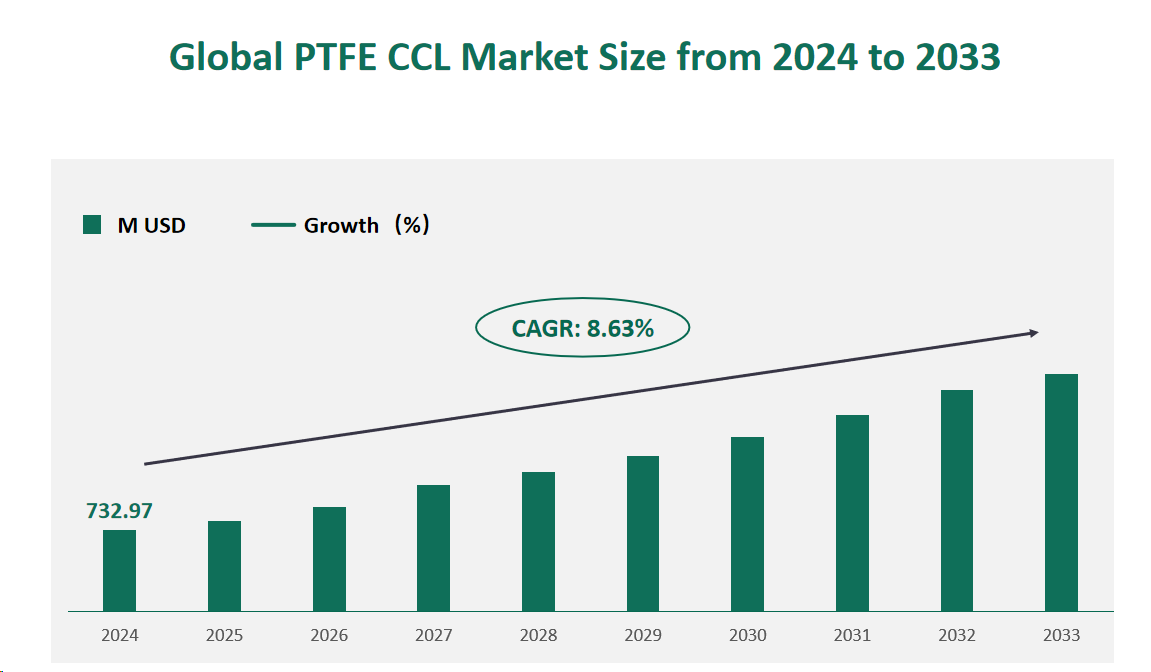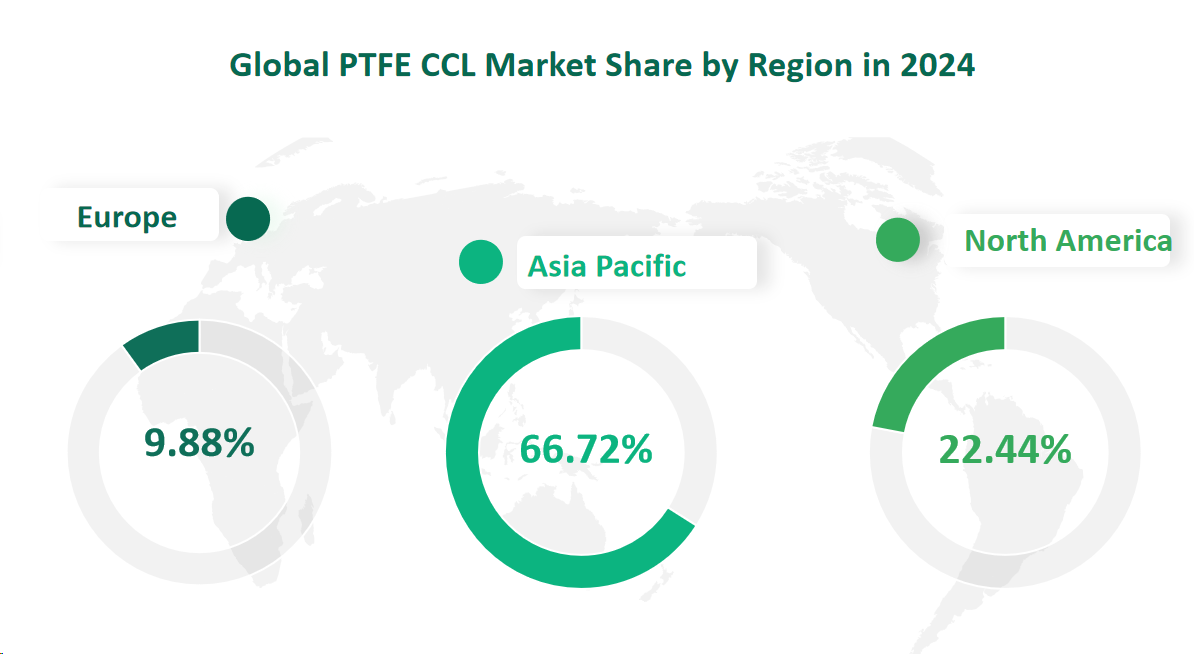1 Global PTFE CCL Market Size (Value) and CAGR (2024-2033)
In 2024, the global PTFE CCL market is projected to be valued at $732.97 million USD. The Compound Annual Growth Rate (CAGR) for the period from 2024 to 2033 is anticipated to be 8.63%.
Copper Clad Laminate (CCL) is a type of PCB base material, it is laminated with copper clad on both sides and reinforced with resin-soaked glass fiber fabric. CCL is formed by lamination of copper foil onto both sides of resin-impregnated glass fabric sheets. Polytetrafluoroethylene (PTFE) is a type of synthetic resin derived by polymerizing tetrafluoroethylene. It features resistant and non-flammable qualities and has a waxy surface finish.
PTFE CCL is a form of CCL (copper clad laminate) with PTFE as the core material. PTFE is a highly important substance in the electrical engineering industry due to its exceptional dielectric characteristics.
Figure Global PTFE CCL Market Size (M USD) and CAGR 2024-2033

2 PTFE CCL Market Growth Drivers and Industry Trends
The PTFE CCL market is experiencing significant growth, driven by a multitude of factors and industry trends. One of the primary growth drivers is the expansion of downstream applications, particularly in high-frequency communications and the advent of 5G technology. The increasing demand for high-speed data transmission and the need for stable, low-loss signal carriers have made PTFE CCL an essential material in the electronics industry.
The industry trend towards the miniaturization and densification of electronic components has led to a surge in the demand for high-performance substrates like PTFE CCL. As 5G networks require high-frequency circuit substrates for signal transmission at frequencies above 1GHz, PTFE CCL finds extensive use in wireless networks, transmission networks, and data communications. The construction of 5G base stations, with their increased density and smaller coverage range, will require a substantial number of high-frequency substrates, further driving the market growth.
Another trend is the development of multi-layer PCBs, which necessitates PTFE CCL products capable of complex structural processing while maintaining excellent dielectric properties. Leading companies in the industry, such as Rogers and AGC, are innovating with technologies like hollow ball filling and nanoscale fillers to improve dimensional stability and processing reliability. These advancements not only enhance product performance but also position the industry for future growth in high-frequency applications.
3 Challenges and Restraints in the PTFE CCL Market
Despite the promising growth prospects, the PTFE CCL market faces several challenges and restraints. One of the primary challenges is the stringent environmental regulation. The production process of PTFE CCL involves various industrial links that can generate pollutants if not properly managed, leading to potential environmental impacts. As global environmental policies become increasingly strict, companies in the PTFE CCL industry may face higher environmental compliance costs, affecting their profitability.
The high barriers to market entry also pose a challenge. These barriers include patented formulas, complex manufacturing processes, and the need for certification from terminal manufacturers. The diverse range of substrate materials required for different applications necessitates the development of multiple product formulas, which is a significant investment for new entrants.
The availability of alternative substrates presents another challenge. Materials like epoxy-based CCLs offer different benefits and are often more cost-effective, which can impact the market share of PTFE CCL. Furthermore, the competition within the industry is intensifying as more companies enter the market, potentially leading to oversupply and reduced product prices. This increased competition, coupled with the potential for market saturation, could impact the profitability of the PTFE CCL industry.
4 Global PTFE CCL Market Size and Share by Type in 2024
The global PTFE CCL market is segmented into two distinct types, each with its own market revenue projections for 2024.
Fiberglass PTFE CCL, which is expected to dominate the market in 2024, is a type of PTFE CCL reinforced with glass fibers. This material is valued for its excellent mechanical strength, thermal stability, and electrical insulation properties. It is widely used in the manufacturing of high-frequency and high-speed printed circuit boards (PCBs), particularly in applications such as communication equipment, satellites, radar, and filters. The market revenue for Fiberglass PTFE CCL in 2024 is forecasted to be $618.74 million USD, reflecting its substantial share in the total PTFE CCL market revenue.
Ceramic-Filled PTFE CCL, on the other hand, is a type of PTFE CCL that incorporates ceramic materials to enhance its dielectric properties. This type is designed to provide low dielectric loss and minimal signal distortion, making it ideal for microwave applications. Ceramic-Filled PTFE CCL is used in advanced technologies such as automotive radar, network servers, and aerospace and defense systems that require high-frequency communication capabilities. The market revenue for this type in 2024 is projected to be $114.23 million USD, indicating a growing demand for its specialized applications.
Table Global PTFE CCL Market Size and Share by Type in 2024
Type | Market Size (M USD) 2024 | Market Share 2024 |
Fiberglass PTFE CCL | 618.74 | 84.42% |
Ceramic-Filled PTFE CCL | 114.23 | 15.58% |
5 Global PTFE CCL Market Size and Share by Application in 2024
The global PTFE CCL market, when segmented by application, reveals a diverse landscape with distinct revenue projections for 2024. PTFE CCL is utilized in a variety of applications due to its superior dielectric properties, thermal stability, and chemical resistance.
In 2024, the Communications Equipment sector is anticipated to generate the highest market revenue, with an estimated $256.82 million USD, reflecting a significant share of the total PTFE CCL market revenue. This sector’s growth is fueled by the increasing demand for high-frequency and high-speed PCBs in satellites, radar, filters, and other communication devices. The Antenna application is expected to be the fastest-growing, with a projected revenue of $105.41 million, driven by the widespread deployment of base station antennas and the integration of PTFE CCL in advanced antenna systems.
The Automotive sector, with its use of PTFE CCL in automotive electronic control systems and ADAS systems, is projected to generate $127.19 million, while the Network Server application, crucial for cloud servers and high-end routers, is forecasted to yield $28.37 million. The Aerospace and Defense sector, requiring high-frequency communication support, is expected to contribute $142.25 million to the market revenue. Lastly, the Others category, which includes industrial control and aerospace industries, is projected to generate $72.92 million.
Table Global PTFE CCL Market Size and Share by Application in 2024
Application | Market Size (M USD) 2024 | Market Share 2024 |
Communications Equipment | 256.82 | 35.04% |
Antenna | 105.41 | 14.38% |
Automotive | 127.19 | 17.35% |
Network Server | 28.37 | 3.87% |
Aerospace and Defense | 142.25 | 19.41% |
Others | 72.92 | 9.95% |
6 Global PTFE CCL Market Size and Share by Region in 2024
Asia Pacific emerges as the largest revenue generator of PTFE CCL market, with an impressive $489.07 million USD in 2024. This region’s dominance can be attributed to the rapid industrialization and technological advancements in countries like China, which has become a hub for electronics manufacturing. The region’s growth is also supported by the increasing demand for high-performance materials in the automotive and telecommunications sectors.
North America follows with an expected revenue of $164.45 million USD, with the United States being a key contributor due to its strong presence in the aerospace and defense industries. Europe is projected to generate $72.39 million USD, with Germany leading in the adoption of advanced materials for automotive and industrial applications. The Middle East and Africa are expected to contribute $7.06 million USD, with significant growth potential in the oil and gas industries, which require high-performance materials for severe environment applications.
Latin America, although currently holding a smaller share, is anticipated to experience rapid growth, with Brazil and Mexico driving the demand for PTFE CCL in the automotive and renewable energy sectors.
Figure Global PTFE CCL Market Share by Region in 2024

7 Major Players in Global PTFE CCL Market
7.1 Rogers Corporation (Arlon)
Rogers Corporation, established in 1832 and headquartered in Chandler, Arizona, USA, is a global leader in engineered materials solutions. The company manufactures products in the United States, China, Japan, Korea, Germany, Hungary, and Belgium, serving a wide range of applications including EV/HEV, automotive safety, radar systems, mobile devices, and renewable energy.
Rogers offers a diverse range of PTFE CCL products, including RT/duroid® Laminates and RO3000® Series, known for their high reliability and superior performance in high-frequency applications.
In 2024, Rogers Corporation reported a revenue of $317.22 million USD and a gross margin of 43.25%.
7.2 AGC (Park Electrochemical and TACONIC)
AGC, founded in 1907, has evolved from being Japan’s first flat glass producer into a global solutions provider in Glass, Electronics, Chemicals, and Ceramics industries. With a strong presence in more than 30 countries, AGC has committed to mobility, electronics, and life science businesses.
A significant recent development for AGC was the integration of Nelco and Taconic brands to offer high-value dielectric substrates for high-frequency electronics. AGC’s product offerings include TLC-32 laminates and EZ-IO-F, which are engineered for cost-effectiveness and thermal stability in a range of microwave applications.
In 2024, AGC reported a revenue of $181.84 million USD and a gross margin of 32.07%.
7.3 Shengyi Technology
Shengyi Technology, established in 1985, is a global core supplier of electronic circuit substrates with a focus on R&D, production, sales, and service. The company is recognized for its high-standard, high-quality, high-performance, and high-reliability products.
Shengyi Technology’s recent developments include the expansion of its product line to meet the growing demand for high multilayer circuit boards used in various electronic products. The company offers products such as mmWave77 and SG7350D2, which are designed for automotive radar applications, base station antennas, and satellite communication.
In 2024, Shengyi Technology reported a revenue of $95.55 million USD and a gross margin of 27.94%.

